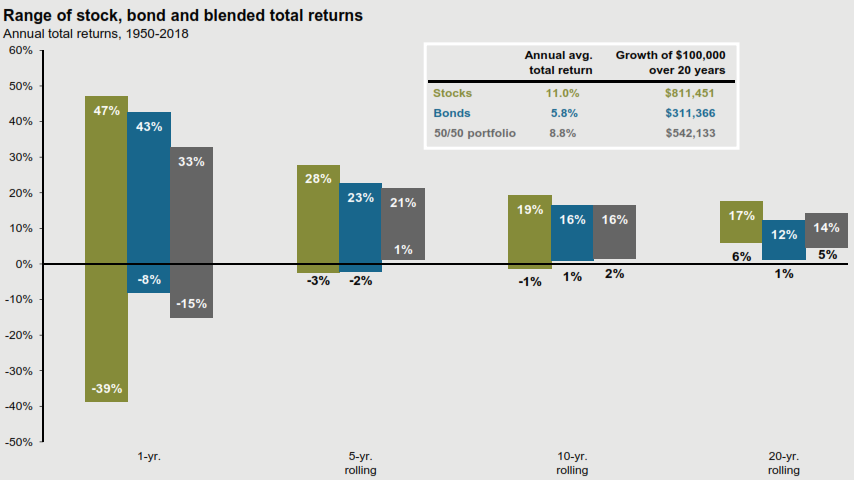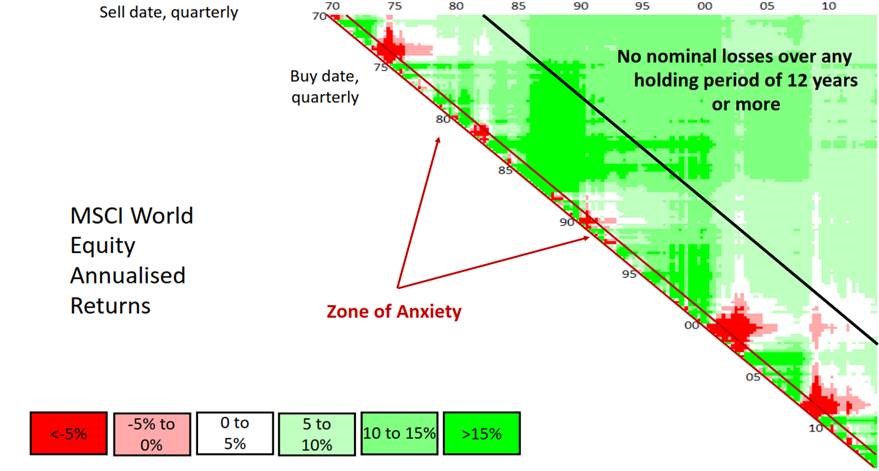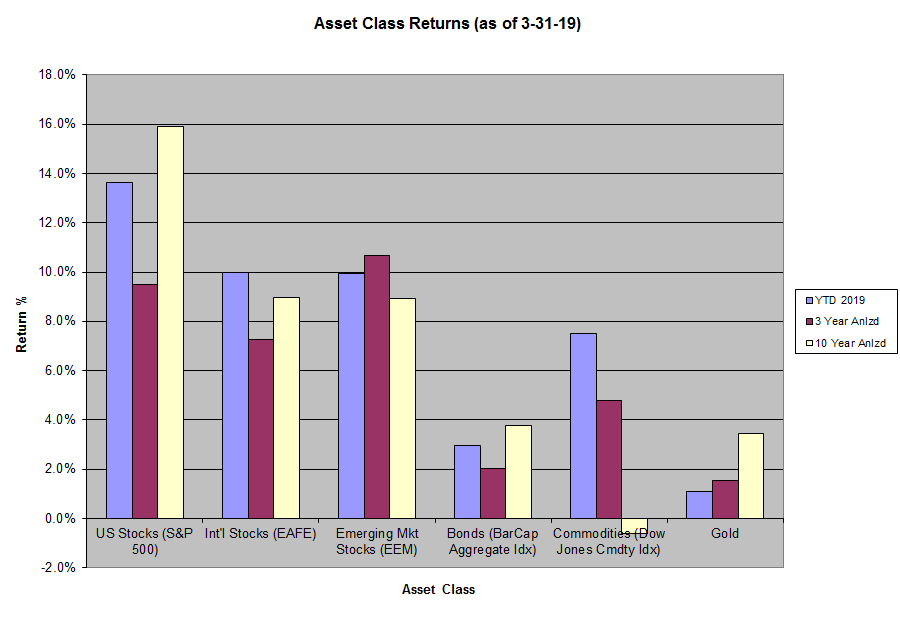AMM Second Quarter 2019 Client Letter
Anyone who has even casually sought investment advice has likely heard the adage “invest for the long-term”. It’s probably the most commonly dispensed piece of investment advice – right up there with “don’t put all your eggs in one basket”. While “invest for the long run” is a good pieces of advice, it remains challenging in practice. Perhaps the biggest challenge to investing for the long run is us – humans. We just don’t do a great job of predicting the future. Not just what might happen in our financial lives, but also what might make us happy and what we might value most 10 or 20 years in to the future.
The short run is where we live. It’s where the action and excitement is, but it is also where the danger to our portfolio lurks in plain sight. We’re not talking about recessions, asset bubbles, toxic political environments, runaway inflation, trade wars, etc. These are all very real risks. But the bigger risk is how we react to these short-term events in the context of a long-term portfolio strategy.
Exhibit A, provided by Oxford Risk, is a heat map representation of short and long-term returns. The diagonal represents your purchase date and the horizontal your sell date. To read the chart simply pick a “buy” date from the diagonal and then choose a “sell” date from the horizontal along the top. The intersection of these dates is the annualized rate of return of a portfolio invested in a global stock index (MSCI World) over the holding period you selected. As to be expected the longer the time frame held (upper right) the greater the likelihood of higher returns.
Over the period of this chart, most investors achieve a positive annualized return within 1-3 years, with the big exceptions being the early 70s and the lost decade of the 2000s which was hit with two distinct market selloffs (tech bubble and financial crisis). However, the one year period (thin line) is pockmarked with significant periods of negative returns. This is the proverbial short-term. It is where most of us are psychologically and where we are most prone to make investment decisions based on market swings, vs. rational long-term positioning. Ultimately this thinking leads to errors which push the green pastures of higher returns further and further out of reach.
The first goal of the long-term investor should be to reconcile their short-term mindset with the reality of long-term investing. Had you begun investing at the height of the market in 2000 you would have had to wait nearly twelve years to break even. So twelve years is a reasonable stress test for the kind of long-term commitment required for stock investors. Yes, twelve years is a very long time to wait to break even. But it is important to remember that this outcome, while possible, is not probable based on history.
Exhibit B shows the range of annualized returns over various rolling time frames for a portfolio comprised of 100% stocks, 100% bonds and a 50/50 blend of stocks and bonds over various time periods. While negative annualized rates of returns do occur for the pure stock and bond portfolios over rolling 5 year periods, these instances are very rare. Importantly, the blended portfolio doesn’t experience a negative outcome over any period beyond 5 years, and no portfolio experiences a negative outcome at 20 years.

Source: Barclays, Bloomberg, FactSet, Federal Reserve, Robert Shiller, Strategas/Ibbotson, J.P. Morgan Asset Management
In addition to maintaining a long-view of your investment portfolio, we utilize several strategies in an effort to reduce the time to “break-even” following market downturns and bringing the green pastures of positive investment returns nearer:
1). Diversification: The blended portfolio highlighted in Exhibit B above never experiences a negative annualized return period of 5 years or more. By simply incorporating two different assets in the portfolio (stocks and bonds), the risk of experiencing a long period of negative annualized returns is reduced dramatically. Yes, returns are reduced too but this is a trade-off some investors – especially those at or near retirement – should strongly consider.
2) Invest throughout the cycle: If you are regularly investing money, you may be tempted to stop when markets decline. STOP and think about what this means to your portfolio. Doing this means that you were happy investing at higher prices, but now that prices are more favorable you want to stop investing. Unless you have an absolute need for the funds during a downturn, sticking with the discipline of regularly investing savings will mean that you will obtain more favorable prices during a downturn and ultimately shorten your recovery time to achieving positive returns once again.
3) Rebalance: Periodically rebalancing your portfolio has the effect of selling assets that have gone up, and buying those that have gone down to bring your portfolio back in line with its pre-determined asset allocation strategy. This essentially has the effect of selling high and buying low over the long-run. Doing this on a fairly frequent basis should also help in shortening your recovery time during a major swoon.
4) Focus on Dividends: Stocks generate returns via price appreciation and dividends. A focus on businesses that pay, and ideally, increase their dividend distributions to shareholders can help to alleviate concerns that accompany severe market corrections. The positive cash flow provided by dividends can also help to cushion the portfolio during downturns.
First Quarter Review
Year-to-date through 3/31/19, domestic stocks (S&P 500) increased 13.7%, developed international stocks (EAFE) increased 10%, and emerging markets (EM) increased 9.9%. Bonds (Bar Cap Agg Idx) increased 2.9%, commodities were up 7.5% and gold gained 1.1%. We have updated our asset class return chart (Exhibit C) to reflect YTD 2019 along with three and ten year annualized returns for the aforementioned asset classes.
Following a fairly horrendous 4th quarter, asset prices generally rebounded across the board in Q1. The Fed has reversed course on their plan to increase rates in 2019 cutting their projected two additional hikes down to zero. This has taken pressure off of rates and helped to reprice risk assets higher. A major trade deal with China also appears to be gaining traction with both sides signaling progress on this front. Markets are likely pricing in expectations of some kind of deal – though whether the market’s bullish action is entirely warranted remains to be seen. The devil will be in the details!
The net result of the market’s big Q4 drop and subsequent “v” shaped recovery is that stocks are not far from where they stood 6 months ago. As investors we shouldn’t at all be surprised by this erratic behavior. If there is a grand design of asset markets it is that they are “pricing machines”. Every day millions of traders, investors and other market participants make buy and sell decisions based on their view of the future. But since the future is unknowable, any time “new” information is introduced the market must “price” this accordingly. The Fed’s U turn on rates was “new” information which the market has subsequently digested by higher prices in the market. What new information tomorrow brings remains unknown.
Rather than try to predict the future we seek to understand the present and invest accordingly. Our current assessment of the present environment could best be characterized as neutral with a tilt towards caution. On the positive side, the economy remains strong with very low unemployment and high job availability. Inflation remains in check, and the Federal reserve has moved decidedly dovish. Consumer confidence, while a historically lagging indicator, remains high. On the stock front, earnings for S&P 500 are expected to hit all-time highs in 2019. With interest rates on government bonds dropping nearly 20% over the last 6 months, stocks appear attractive relative to bonds.
On the more cautious side of the equation, the national debt is now 105% of GDP as of the end of 2018 up from 64% of GDP prior to the financial crisis. While the economic expansion has been going for many years now, deficit spending remains persistently high relative to where we are in the economic cycle. This goes against the traditional countercyclical theory of fiscal policy, whereby spending should be reduced in good times and expanded in bad times. Times are good right now, perhaps very good, but debt and government spending continue to move higher. The stock market, while attractive relative to bonds, is at all-time highs and looks fairly valued at best on an absolute basis. Any new and material bad news or a resumption of rising rates will likely not be absorbed well by stocks.
As is always this case, there are plenty of positives and negatives to digest. But the bottom line in our view is that we are nearer to the end than the beginning of this cycle – though it could go on for many more years. Greater caution is now warranted and most portfolios reflect this via below target equity weightings and higher general credit quality*. Importantly caution does not mean that we are predicting an imminent bear market or recession, but rather the current environment warrants a marginally more cautious positioning than it did earlier in this cycle. Of course change is a constant in financial markets, so our views will continue to evolve with new information and we will actively make adjustments as warranted.
*Individual accounts will vary based on a client’s stated objectives, risk tolerance and time frame. We manage several different portfolio strategies, so not every client has exposure to the securities, asset classes or investment strategies discussed above. In addition to growth and/or income oriented asset allocation strategies, we also manage more concentrated equity portfolios that generally carry a higher degree of risk and volatility.
In March, we filed the annual amendment of our firm’s ADV brochure dated March 25, 2019 with the Securities and Exchange Commission. Pursuant to regulatory requirements, we have included a document that itemizes the material changes to the last amended brochure. We can provide you with a full copy of the ADV filing at your request.
Should you have any questions regarding your investment account(s) and personal financial plans, or if there have been any recent changes to your investment and/or retirement objectives, please do not hesitate to contact our office to speak with one of us at your convenience.
As always, we thank you for entrusting AMM to help you achieve your investment and retirement objectives.
Your Portfolio Management Team





